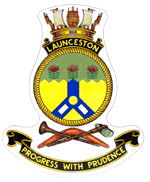
HMAS Burnie (J198/B238/A112), named for the city of Burnie, Tasmania, was one of 60 Bathurst class corvettes constructed during World War II and one of 20 built for the Admiralty but manned by personnel of and commissioned into the Royal Australian Navy (RAN).

HMAS Colac (J242/M05), named for the town of Colac, Victoria, was one of 60 Bathurst-class corvettes constructed during World War II, and one of 36 initially manned and commissioned solely by the Royal Australian Navy (RAN).

HMAS Cootamundra (J316/M186), named for the town of Cootamundra, New South Wales, was one of 60 Bathurst-class corvettes constructed during World War II, and one of 36 initially manned and commissioned solely by the Royal Australian Navy (RAN).

HMAS Deloraine (J232/M232), named for the town of Deloraine, Tasmania, was one of 60 Bathurst-class corvettes constructed during World War II, and one of 36 initially manned and commissioned solely by the Royal Australian Navy (RAN). In January 1942 she evaded an attack by the Japanese submarine I-124 north-west of Darwin and was jointly credited with the submarine's sinking after inflicting the initial damage. She was present at the bombing of Darwin and survived unscathed.

HMAS Echuca (J252/M252), named for the town of Echuca, Victoria, was one of 60 Bathurst-class corvettes constructed during World War II, and one of 36 initially manned and commissioned by the Royal Australian Navy (RAN).

HMAS Goulburn (J167/B243/A117), named for the city of Goulburn, New South Wales, was one of 60 Bathurst-class corvettes constructed during World War II, and one of 20 ordered by the British Admiralty but subsequently manned and commissioned solely by the Royal Australian Navy (RAN).

HMAS Kalgoorlie (J192/B245/A119), named for the city of Kalgoorlie, was one of 60 Bathurst-class corvettes constructed during World War II and one of 20 built for the Admiralty but manned by personnel of and commissioned into the Royal Australian Navy (RAN).

The Bathurst-class corvettes were a class of general purpose vessels designed and built in Australia during World War II. Originally classified as minesweepers, but widely referred to as corvettes, the Bathurst-class vessels fulfilled a broad anti-submarine, anti-mine, and convoy escort role.

HMAS Rockhampton (J203/M203), named for the city of Rockhampton, Queensland, was one of 60 Bathurst-class corvettes constructed during World War II, and one of 36 initially manned and commissioned solely by the Royal Australian Navy (RAN).

The first HMAS Bendigo (J187/B237/A111) was a Bathurst-class minesweeper, a group commonly known as corvettes and including escort and patrol duties along with minesweeping.

HMAS Cairns (J183), named for the city of Cairns, Queensland, was one of 60 Bathurst-class corvettes constructed during World War II and one of 20 built for the Admiralty but manned by personnel of and commissioned into the Royal Australian Navy (RAN).

HMAS Bathurst (J158), named for the city of Bathurst, New South Wales, was the lead ship of 60 Bathurst-class corvettes constructed during World War II and one of 20 built for the Admiralty but manned by personnel of and commissioned into the Royal Australian Navy (RAN). Constructed during 1940, the ship spent most of her early career operating with the British Eastern Fleet in the Indian Ocean. She returned to Australian waters in late 1944, then was deployed to New Guinea in 1945, but saw little action. Bathurst was paid off in 1946, and sold to a Sydney scrap merchant in 1948.

HMAS Wollongong (J172), named for the city of Wollongong, New South Wales, was one of 60 Bathurst-class corvettes constructed during World War II and one of 20 built for the Admiralty but manned by personnel of and commissioned into the Royal Australian Navy (RAN).

HMAS Cessnock (J175/B240/A114), named for the town of Cessnock, New South Wales, was one of 60 Bathurst-class corvettes constructed during World War II and one of 20 built for the Admiralty but manned by personnel of and commissioned into the Royal Australian Navy (RAN).

HMAS Whyalla (J153/B252), named for the city of Whyalla was one of 60 Bathurst-class corvettes constructed during World War II and one of 20 built on Admiralty order but manned by personnel of and later commissioned into the Royal Australian Navy (RAN). The ship was sold to the Victorian Public Works Department at the end of the war, who renamed her Rip and used her as a maintenance ship. In 1984, she was purchased by Whyalla City Council, who put her on display as a landlocked museum ship in 1987.

HMAS Fremantle (J246/M246), named for the port city of Fremantle, Western Australia, was one of 60 Bathurst-class corvettes constructed during World War II, and one of 36 initially manned and commissioned solely by the Royal Australian Navy (RAN).

HMAS Gawler (J188/B241/A115), named for the town of Gawler, was one of 60 constructed during World War II and one of 20 Bathurst-class corvettes built for the Admiralty but manned by personnel of and commissioned into the Royal Australian Navy (RAN). The ship was laid down by BHP at its Whyalla shipyard in early 1941, launched later that year, and commissioned in 1942.

HMAS Geelong (J201), named for the city of Geelong, Victoria, was one of 60 Bathurst-class corvettes constructed during World War II, and one of 36 initially manned and commissioned solely by the Royal Australian Navy (RAN).

HMAS Launceston (J179/B246/A120), named for the city of Launceston, Tasmania, was one of 60 Bathurst-class corvettes constructed during World War II and one of 20 built for the Admiralty but manned by personnel of and commissioned into the Royal Australian Navy (RAN).

HMAS Toowoomba (J157/B251/A125), named for the city of Toowoomba, Queensland was one of 60 Bathurst-class corvettes constructed during World War II and one of 20 built on Admiralty order but manned by personnel of and later commissioned into the Royal Australian Navy (RAN). The ship later served in the Royal Netherlands Navy (RNN) as HNLMS Boeroe.





















